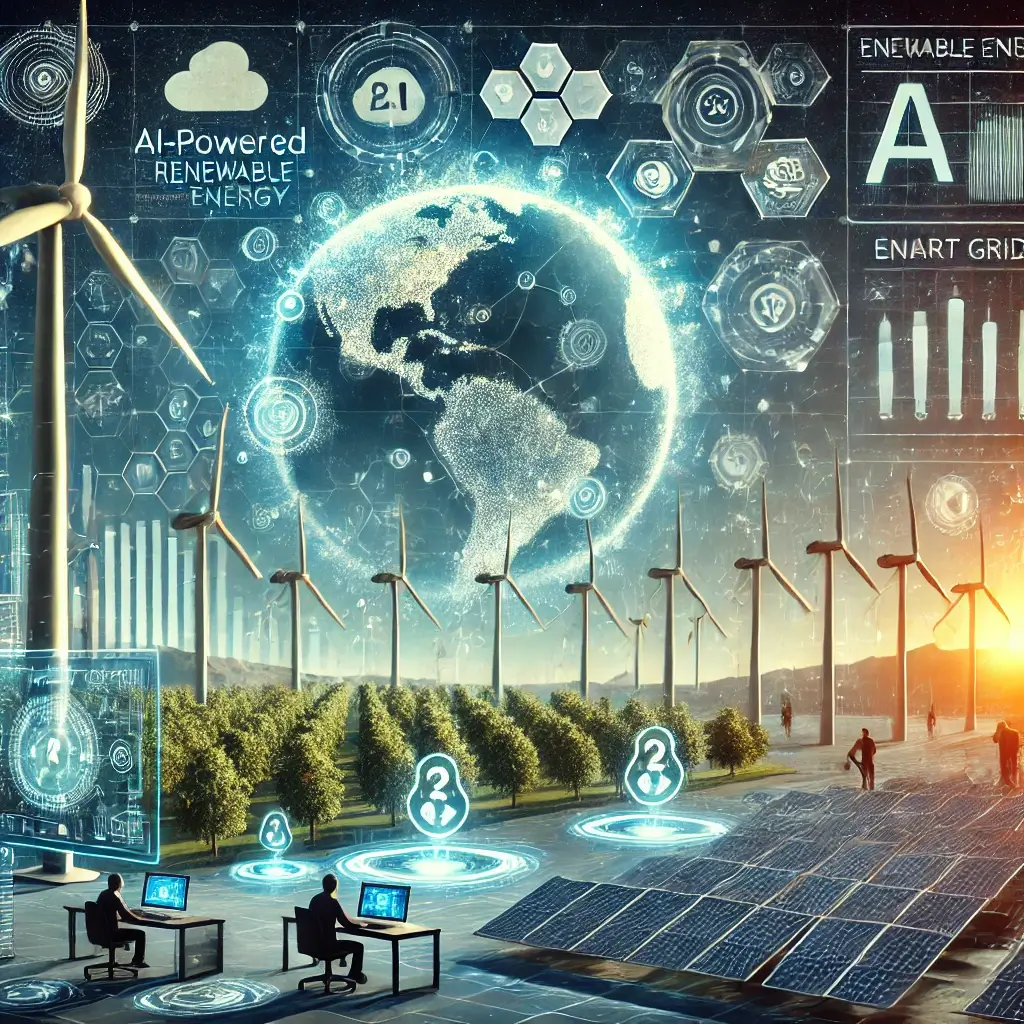-
How Digital Nomads Are Redefining Work and Lifestyle 🌍💻
Mar 06, 2025 | 38 Comments -
How Artificial Intelligence is Transforming Healthcare 🏥🤖
Mar 06, 2025 | 0 Comments -
How Cryptocurrency is Reshaping the Global Economy 💰🌍
Mar 06, 2025 | 0 Comments -
How to Build a Strong Personal Brand: Stand Out & Grow Your Influence 🚀📢
Mar 02, 2025 | 0 Comments -
The Power of AI in Business: How Artificial Intelligence is Transforming Industries 🚀🤖
Mar 02, 2025 | 0 Comments -
How Smart Homes Are Changing the Way We Live 🏡🔋
Mar 02, 2025 | 0 Comments -
How Electric Vehicles Are Revolutionizing Transportation 🚗⚡
Mar 02, 2025 | 0 Comments -
The Future of Renewable Energy: How Green Technology is Changing the World 🌍⚡
Mar 02, 2025 | 0 Comments

The Future of Renewable Energy: How AI and Innovation Are Powering Sustainability
As the world shifts toward a sustainable future, renewable energy is becoming the foundation of global power generation. Advances in artificial intelligence (AI), smart grids, and battery storage are making solar, wind, and hydroelectric energy more efficient and accessible. Governments and businesses are investing heavily in clean energy technologies to combat climate change and reduce reliance on fossil fuels.
The Importance of Renewable Energy
Renewable energy is essential for reducing greenhouse gas emissions and ensuring long-term energy security. Unlike fossil fuels, clean energy sources such as solar and wind power are abundant and environmentally friendly.
Key Renewable Energy Technologies
Several clean energy technologies are driving the transition to a sustainable future.
1. Solar Power Innovation
Solar energy is one of the fastest-growing renewable energy sources, with advances in photovoltaic (PV) technology improving efficiency and affordability.
- Perovskite solar cells increase energy conversion rates.
- AI optimizes solar panel placement for maximum sunlight exposure.
- Solar farms integrate battery storage for nighttime energy use.
2. Wind Energy Efficiency
Wind power is a key player in renewable energy production, with innovations enhancing turbine efficiency and reliability.
- AI predicts wind patterns to maximize energy output.
- Offshore wind farms generate consistent power with stronger wind currents.
- Next-generation wind turbines feature larger blades for increased efficiency.
3. Hydroelectric and Ocean Energy
Hydropower remains a significant renewable energy source, while wave and tidal energy are emerging solutions.
- Pumped storage hydropower balances energy supply and demand.
- AI monitors dam operations for efficiency and safety.
- Wave and tidal energy projects expand as cost-effective alternatives.
AI and Automation in Renewable Energy
Artificial intelligence is transforming the renewable energy sector by optimizing energy production, forecasting demand, and managing smart grids.
1. AI-Powered Energy Forecasting
Machine learning models predict energy demand and optimize supply.
- AI analyzes weather patterns for accurate solar and wind forecasts.
- Smart energy grids adjust distribution based on consumption patterns.
- AI-driven algorithms enhance energy efficiency in smart homes.
2. Smart Grid Technology
Smart grids enable real-time energy distribution, reducing power outages and waste.
- AI controls energy flow based on real-time demand.
- Distributed energy storage improves reliability and efficiency.
- Grid automation detects and prevents energy losses.
3. Energy Storage and Battery Innovation
Advanced battery storage solutions improve the reliability of renewable energy.
- Lithium-ion batteries provide efficient energy storage.
- Solid-state batteries offer longer lifespan and faster charging.
- Hydrogen fuel cells emerge as a clean energy storage alternative.
Government Policies and Investments in Clean Energy
Governments worldwide are investing in renewable energy projects and implementing policies to promote sustainability.
1. Global Renewable Energy Targets
Countries are setting ambitious goals for carbon neutrality and clean energy adoption.
- The EU aims for 100% renewable energy by 2050.
- China leads in solar panel production and green infrastructure.
- The U.S. plans to invest $500 billion in clean energy projects.
2. Tax Incentives and Subsidies
Governments provide financial incentives to promote renewable energy adoption.
- Solar tax credits reduce installation costs for homeowners.
- Grants support research and development in clean technology.
- Carbon pricing policies encourage businesses to invest in sustainability.
Challenges Facing Renewable Energy Adoption
Despite its growth, the renewable energy sector faces several challenges.
- Energy Storage Limitations: Battery technology must improve to store surplus energy.
- Grid Infrastructure: Existing grids need upgrades to handle decentralized energy sources.
- Initial Costs: High upfront investments deter small businesses and homeowners.
- Intermittency Issues: Solar and wind power depend on weather conditions.
Future Innovations in Renewable Energy
Cutting-edge technologies are shaping the future of clean energy.
1. Fusion Energy
Nuclear fusion promises limitless clean energy with minimal waste.
- Research advances in plasma containment for fusion reactors.
- Experimental fusion plants aim for commercial viability by 2035.
- AI optimizes reactor efficiency for sustainable power generation.
2. Space-Based Solar Power
Solar satellites could collect energy in space and transmit it to Earth.
- Wireless energy transmission eliminates land use concerns.
- 24/7 solar energy harvesting bypasses nighttime limitations.
- Countries explore partnerships for large-scale orbital solar projects.
Conclusion
Renewable energy is the key to a sustainable future, with AI, smart grids, and innovative battery storage solutions driving progress. Governments, businesses, and consumers must work together to accelerate clean energy adoption and reduce carbon emissions. As technology advances, the vision of a world powered by 100% renewable energy is becoming increasingly achievable.
0 comments
No comments yet. Be the first to comment!
Your comment